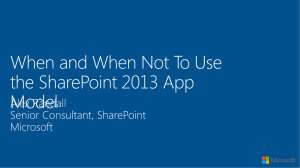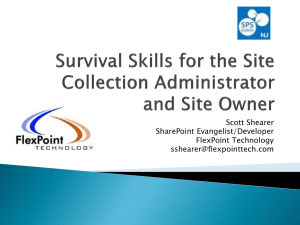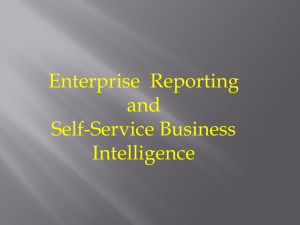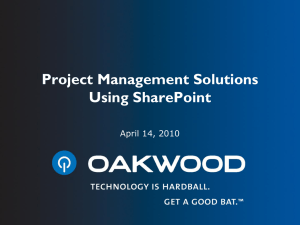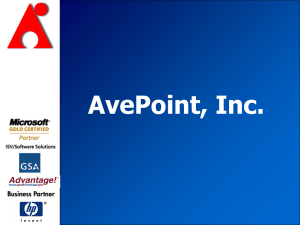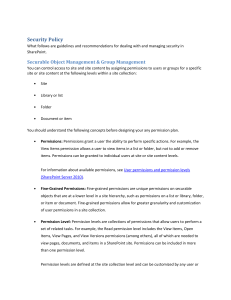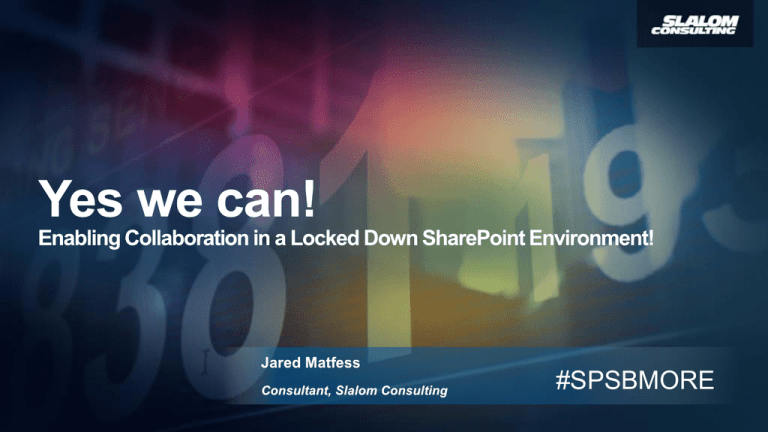
#SPSBMORE
About Me
SharePoint Consultant with Slalom Consulting
10+ years in the IT Field, 0 book deals
President of CT SharePoint Users Group (www.ctspug.org)
Blog: www.jaredmatfess.com
Twitter: @JaredMatfess
E-mail: Jared.Matfes@outlook.com
3
My Background
Worked 11 years at United Technologies Corporation
Started in Communications as a co-op
SharePoint, Infrastructure, Networking, Project Management, eBusiness
Designed their US/FN collaboration solution for non-technical data collaboration
4
Presentation Background
SharePoint has the potential to drastically disrupt the normal operations for
large corporations
Navigating the political/social stigma of a collaborative technology in a regulated
industry can be fun
Here are some best practices, lessons learned, and tips for your own
implementation
5
6
SharePoint
SharePoint makes it almost too easy to share files
Upload, Sync, Drag & Drop, Open in Explorer
Multiple devices supported
It also includes Share in the name!
7
What your CSO wants for SharePoint
8
What your users want
9
Why do mistakes happen?
People – someone shares a file with someone who shouldn’t see it
Process – the process for sharing data failed
Technology – there weren’t adequate controls in place to enable to required
collaboration while including mistake proofing steps
10
Where am I?
File shares are very ambiguous and lead to mistakes
Users might understand the title but not the purpose for the share
How would a user know the difference between the N & O Drives?
11
What matters to your users?
Would Carl purposely upload a sensitive document to an open SharePoint site?
12
13
A.C.T. – The Keys to Success
14
What are your data concerns?
Intellectual property?
Company private/sensitive such as salary planning?
Mergers and acquisitions data which could impact stock price?
Are the concerns regulatory? HIPPA, Export Control, PII?
Are there retention policies surrounding your data?
15
You need to engage your business!
Information Technology Security
Compliance
Legal
Human Resources
16
Your goal – guide your users to success
17
Define your data security requirements
Identify logging/auditing requirements
Target the data which needs to be secured
Leverage existing DRM technology
Force data classification on data upload
User / data separation requirements
18
What do you want to audit?
19
How long do you want to keep the data?
Recommend enabling audit trimming
Consider 3rd party solution such as AvePoint Report Center for long-term
archiving / reporting on audit data
20
Reporting
Try to map your user requirements to relevant reports
Help drive the audit discussion so you can help shape the report outputs
Consider custom applications built on-top of SharePoint
Consider a 3rd party vendor: AvePoint, HarePoint, Metalogix, WebTrends based
on requirements
21
Web Analytics to CSV CodePlex Project!
Chris LaQuerre
VP, CTSPUG
https://sp2013wade.codeplex.com/
22
23
Start at your site request process
Identify your decision making questions
Capture key field as metadata
Store in site collection property bag
Also consider hidden list in site collection
Meet with your customers to understand
what they are requesting
24
Powershell to create custom property
Powershell to add a custom entry CTSPUG President to the property bag
$site = New-Object Microsoft.SharePoint.SPSite("http://www.ctspug.org")
$rootWeb = $site.RootWeb
$rootweb.AllowUnsafeUpdates = $true
$rootweb.Properties.Add("CTSPUG President", "Jared Matfess")
$rootweb.Update()
Consider including this to your Site Collection creation process
25
Expose Site Metadata to Users
Display data captured during site collection process
Ensure you have process for keeping data current
Jeremy Thake
http://goo.gl/emfLVi
26
Data Separation by Web Application
SharePoint
Farm
US Person
Web
Application
Foreign
Person Web
Application
Executive
Only Web
Application
27
Technical Implementation
Created web applications and set user policies that would “Deny All” to users
that did not meet the container requirements.
Relies on global Active Directory Groups such as “All Domain Users”
28
Dynamic groups leveraging claims
Consider having a developer create a custom claims provider
Claims at a high level are conditions you can establish about a user
Example: Marketing user claim can be established if Department = “Marketing”
Use these claims to prevent “Non-Executives” from accessing a web application
Great TechNet Article (written by Scot & Ted Pattinson)
http://msdn.microsoft.com/en-us/library/gg615945.aspx
29
Claims “Gotcha’s”
When setting any sort of “Deny All” consider your administrators and any
service accounts that make SharePoint run!!
How clean is your Active Directory environment?
Make sure your developers consider columns that might be NULL
Perform some analysis on Active Directory data before building anything!
What processes exist to keep user data accurate?
30
Mistake-proofing steps
Include visual cues to help inform users what is acceptable data
PII data is not allowed in this site
31
SharePoint Permissions
#1 Governance decision is who gets what access in SharePoint
Consider custom permissions / roles but be consistent
Example:
Role
Overview
Site Power User
Business Power User who owns the site
IT Power User
Non-SharePoint Team
Contributor (No Delete)
Business user
Web Analytics Viewer
Manager role who needs metrics
32
Who’s managing permissions?
Business Users are managing permissions
Users can give other people “Full Control”
Governance can get thrown out the window
IT is managing permissions
Slows down adoption
Someone has to “do the work”
Hurts ad-hoc collaboration
33
Compromises
Try to only use Active Directory groups for permissions
Rely on existing processes for populating those groups
Give business users “Manage Permissions” but rely on 3rd party tools or custom
scripts to report on user access
Hire a team to manage/oversee this
34
Pro Tip: Group Owners can add users!
You can make your business users the owners for groups and allow them to
add/remove individuals without manage permissions access!
35
ProTip: (continued)
Navigate to the group from the site permissions screen and then add/remove
the user from that screen
36
Manual vs Build vs Buy
Manual: Keep your processes & access tightly controlled
Build a custom solution:
Event receivers on document upload
Timer jobs to confirm configuration
PowerShell scripts for reporting / Web Analytics
Buy: Partner with a 3rd party such as AvePoint / Metalogix / Hi Software
37
Prototype & scale it out
Great ideas can start with a SharePoint Designer Workflow
(but shouldn’t necessarily end with it in a large scale environment)
Work with users to prove out ideas and improve
Consider the implications when everyone is in the system
38
Document classification
There’s no good way to turn classification on for all documents
Don’t modify the out of the box Document Content Type!
Consider leveraging unique Content Types
39
Training & Communication
Executive sponsorship is crucial if the security model is painful
Tailor your adoption training to include security model restrictions
Ramp up a core base of power users to be your ambassadors
Partner with communications to get the message out
40
Recommended adoption session!
http://channel9.msdn.com/Events/SharePoint-Conference/2014/SPC296
41
42
In closing..
SharePoint Security is difficult but there are options
Prototype with simple solutions but always test for scale
Communication & training plans are the keys to success
Don’t be afraid of process improvement
They did name it SharePoint for a reason
43
© 2012 Slalom, LLC. All rights reserved. The information herein is for informational purposes only and represents the current view of Slalom, LLC. as of the date of this presentation.
SLALOM MAKES NO WARRANTIES, EXPRESS, IMPLIED, OR STATUTORY, AS TO THE INFORMATION IN THIS PRESENTATION.





